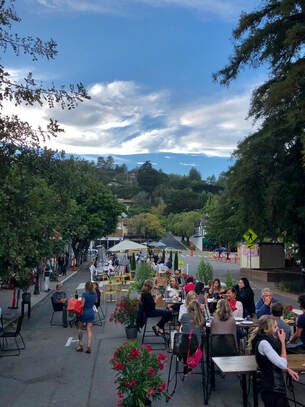When dozens of cities converted some streets to pedestrian-friendly corridors with restricted vehicle access, they became something else: an example of how readily urban space can be repurposed for mobility and play, and how quickly human activity can surge back when cars are removed,” according to Bloomberg. Local officials across the Bay Area and beyond “are weighing whether to keep these temporary installations — known variously as “safe streets,” “slow streets,” “open streets,” and “stay healthy streets” — in place for the long haul, Bloomberg reports. And California State Assemblymember Adrin Nazarian (D-LA) has proposed AB 733, which seeks “to make it easier for cities to make the ‘Slow Streets’ created during the COVID-19 pandemic permanent.”
These types of social spaces “have been critical to enable us to encounter one another and socialize and maintain the social fabric of our communities,” Bela said.
But what about the purely economic case? Would shared spaces – parklets, street closures and other repurposed parking – drive business, and thus sales tax revenue in Mill Valley? How does that shake out when some parking spaces are lost as a result, or if drivers inconvenienced by having to drive around a closure decide to skip that in-person purchase entirely.
New data analysis by Yelp supports some degree of car-free streets being good for the economy.
The firm looked at restaurants in business districts in a variety of cities that had slow streets programs that blocked vehicle access in 2020, including San Francisco’s Mission District. They measured the difference in the share of consumer interest between the sample of restaurants in each slow street zone and all restaurants across each respective city, comparing the start of the pandemic, when these programs weren’t yet in place, to the various time periods when the programs were in swing. Eateries in car-free areas saw more consumer interest (based on the amount of views, posted photos and user reviews on Yelp listings) when their streets were strictly limited to pedestrians and cyclists, according to Bloomberg. THIS CHART SHOWS THAT DIFFERENCE.
The findings mesh with a first-of-its-kind national study by Jenny Liu, an urban studies and planning professor at Portland State University who studies transportation economics. That study looked at the economic impacts of cycling and pedestrian street improvements along 14 corridors in 6 U.S. cities. Counter to oft-heard fears by shop owners that replacing vehicle parking will dry up customer traffic, Liu found positive (and in some cases nonexistent) effects on both sales and employment for adjoining businesses, with particular benefits for restaurants, according to Bloomberg.
“This infrastructure is an upgrade in terms of travel for bikers and walkers, and I think that contributes to revitalizing a district,” Liu said. “It’s all about making the user more comfortable and safe in the context of whatever they’re doing,” Liu told Bloomberg. “The more you can improve upon that, the more you can get people to come out and participate.”

